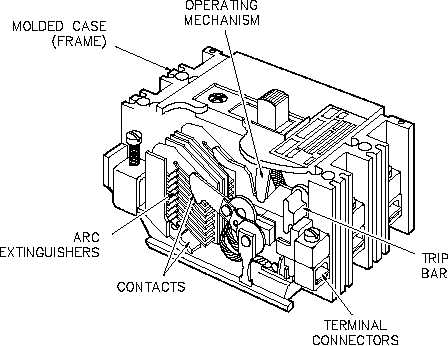CIRCUIT BREAKERS
Electrical Distribution Systems
A cutaway view of the molded case circuit breaker is shown in Figure 5.
Figure 5 Cutaway View of Molded Case Circuit Breaker
A circuit can be connected or disconnected using a circuit breaker by manually moving the
operating handle to the ON or OFF position. All breakers, with the exception of very small ones,
have a linkage between the operating handle and contacts that allows a quick make (quick break
contact action) regardless of how fast the operating handle is moved. The handle is also designed
so that it cannot be held shut on a short circuit or overload condition. If the circuit breaker opens
under one of these conditions, the handle will go to the trip-free position. The trip-free position
is midway between the ON and OFF positions and cannot be re-shut until the handle is pushed
to the OFF position and reset.
A circuit breaker will automatically trip when the current through it exceeds a pre-determined
value. In lower current ratings, automatic tripping of the circuit breaker is accomplished by use
of thermal tripping devices. Thermal trip elements consist of a bimetallic element that can be
calibrated so that the heat from normal current through it does not cause it to deflect. An
abnormally high current, which could be caused by a short circuit or overload condition, will
cause the element to deflect and trip the linkage that holds the circuit breaker shut. The circuit
breaker will then be opened by spring action. This bimetallic element, which is responsive to
the heat produced by current flowing through it, has an inverse-time characteristic. If an
extremely high current is developed, the circuit breaker will be tripped very rapidly.
ES-15
Page 8
Rev. 0

